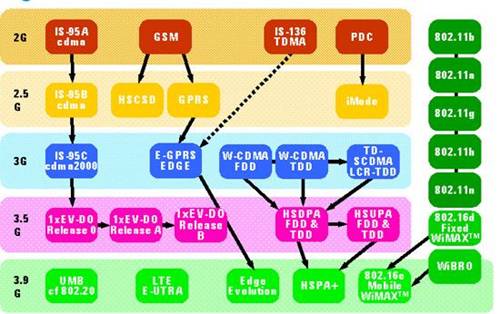Rearden LLC filed an application for experimental license with the FCC on May 24. That caught my eye as as it’s the same company that created a splash in 2011 with its announcement of Distributed-Input-Distributed-Output (DIDO) wireless technology, said to achieve capacity 1000-times the Shannon Limit with sub-millisecond latency. The company issued a white paper authored by company president Steve Perlman and the company’s principal scientist Antonio Forenza, but it didn’t have a lot of details for an engineer. DIDO seemed to be a form of network MIMO, whereby each user is served by all base stations in its vicinity through a complex coordination process. (Various forms of network MIMO will be appearing in successive releases of 3GPP’s LTE Advanced specifications.) Aside from the white paper, there are patents that supported the notion of DIDO as network MIMO.
Archive for the ‘LTE-Advanced’ Category
Rearden discloses more experimental details at FCC’s request, plans to use Clearwire spectrum
Friday, June 21st, 2013Qualcomm outlines vision of 1000x mobile capacity increases
Wednesday, August 29th, 2012In the first of a series of webinars, Qualcomm today began reporting on the results of its “1000x Data Challenge,” an initiative to meet what it sees as the need, someday, to increase mobile capacity 1000-times. The webinar, conducted by Rasmus Hellberg, Qualcomm’s Senior Director of Technical Marketing, was an overview. He discussed spectrum, small cells, and other techniques to increase capacity. More-detailed webinars on each of these are forthcoming: spectrum initiatives on September 18, small cells and heterogeneous networks on October 18, and more efficient networks, applications, and devices on November 14. Today’s webinar should be posted tomorrow, and a white paper should appear in about a week.
CTIA’s International Case for More Spectrum
Tuesday, August 30th, 2011In a recent blog post, CTIA compares some measures of the U.S. wireless industry to those in nine other countries. The purpose is two-fold; to show the U.S. is a leader in number of subscribers, lowest cost per voice minute, and spectrum efficiency, and to argue the need for getting more mobile broadband spectrum in the “pipeline.” These goals are somewhat at odds, and the spectrum-efficiency argument I don’t get, as I’ll explain, but within the constraints of a blog post I think CTIA makes the case that the U.S. is a clear leader in some areas, and that the prospects for more mobile spectrum in the U.S. are fuzzier than they should be today.
Wired versus Wireless
Tuesday, July 19th, 2011The following is my response to a query on LTE versus wired, and the user experience. It capsulizes my current thinking, which evolves.
To your point, I don’t see LTE being competitive with wired in terms of speed or reliability today or in the future. You take the hit there for the convenience of mobile or portable operation. There’s a notion that if we just add enough base stations and repurpose enough spectrum to LTE, we can replicate the home wired experience in the mobile environment, but I don’t think that’s practical. The throughput from an LTE sector is divided among all users in the sector. If everyone wants to watch the Super Bowl at once on LTE, forget it (unless the LTE broadcasting standard is implemented, which let’s everyone watch the same channel like today’s TV (cough)). On FIOS or cable, the Super Bowl is no problem.
Spectrum, Data, Capacity, and PR
Thursday, May 19th, 2011A couple of days ago the Mobile Future coalition posted a short video on YouTube advocating the allocation of more spectrum for mobile broadband. As evidence of the need, it says that, compared to feature phones, smartphones use 24 times the spectrum and tablets 120 times the spectrum.
Reports from NAB and CTIA Address Efficient Use of Spectrum
Saturday, May 14th, 2011Should a Sales Brochure Underlie US Spectrum Policy?
Tuesday, March 29th, 2011The FCC relies on Cisco’s forecast of mobile-broadband data demand as a basis for spectrum policy. Called the Visual Networking Index, it comes up many times in the National Broadband Plan, in other documents, and in speeches.
ITU Loosens Hold on Term “4G” – Now Calls it “Undefined”
Thursday, December 9th, 2010The debate won’t end but the volume is dropping on the what-is-4G controversy. Previously, I’ve written about the ITU’s characterization of 4G as only applying to the two radio technologies it has designated as IMT-Advanced: LTE-Advanced and WirelessMAN-Advanced (the latest version of WiMAX).
What’s 4G? Whatever you want.
Tuesday, October 26th, 2010On October 21 the ITU announced it had deemed two mobile broadband technologies as IMT-Advanced. They’re LTE-Advanced and WirelessMAN-Advanced (WiMAX Release 2 based on IEEE 802.16m). At the same time the ITU called these “true 4G technologies,” leading some in the trade press to say that marketing of some existing services as 4G is misleading.
No entity is the arbiter of the designations 2G, 3G, or 4G. Even the ITU generally uses these terms parenthetically. It recognizes the lack of consensus on their meaning, and does not say others are wrong. The ITU calls the IMT-Advanced technologies “true 4G,” and they are insofar as ITU has a view of 4G and the two technologies are truly consistent with that view.
In some of these articles, Sprint and Clearwire, to name two examples, catch flack for calling their current WiMAX offering 4G. I’d call it 3.5G, but I can’t say they’re wrong. An ABI Research analyst agrees with Sprint and Clearwire; his view is that everything TDMA is 2G, everything CDMA is 3G, and everything OFDMA is 4G, regardless of data rate. It’s a reasonable argument based on backward compatibility, but I’m not ready to agree. If that or something else ends up being the industry consensus, I won’t object.
Below is a comparison found on the ITU website. It’s generally consistent with my view.
Don’t like these classifications? Make your own. Within reason.
________
UPDATED 11/04/2010
ABI analyst link updated with more current post.
